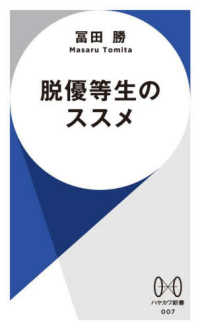- ホーム
- > 洋書
- > ドイツ書
- > Humanities, Arts & Music
- > History
- > prehistory
Full Description
This volume deals with knives and harvesting equipment in Central Europe from their first appearance until the first century of the Common Era. Knives have accompanied human beings since the Paleolithic and became useful tools, weapons, and status symbols over the course of the millennia. An epoch-transcending overview of all common types of knives is provided here for the first time.Harvesting equipment appeared with the new economy of the Neolithic period—first made of silex, then bronze, and finally sickles and scythes of iron. Cutting devices also include scissors, an innovative type of tool that revolutionized textile craft. Each type is described in detail, supplemented with information on dating and propagation as well as further literature.








